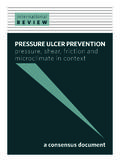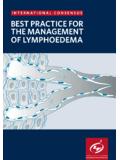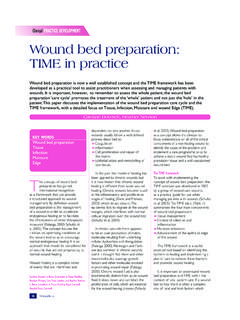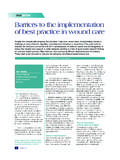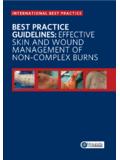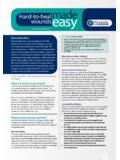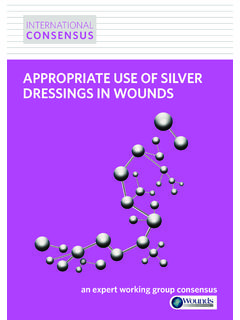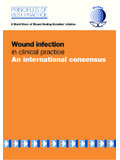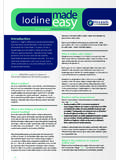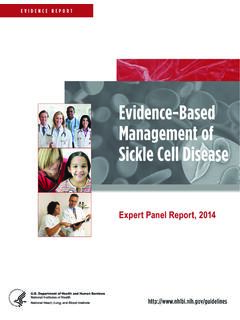Transcription of APPROPRIATE USE OF SILVER DRESSINGS IN WOUNDS
1 APPROPRIATE USE OF SILVER DRESSINGS IN WOUNDS an expert working group consensusINTERNATIONALCONSENSUSEDITOR:Li sa MacGregorPUBLISHER:Kathy DayPUBLISHED BY: WOUNDS International Enterprise House 1 2 Hatfields London SE1 9PG, UK Tel: + 44 (0)20 7627 1510 Fax: +44 (0)20 7627 1570 WOUNDS International 2012 This document has been developed by WOUNDS International and supported by an unrestricted educational grant from B Braun, ConvaTec and Systagenix. The views expressed are those of the expert working group and review panel and do not necessarily reflect those of B Braun, ConvaTec and to cite this document: International consensus . APPROPRIATE use of SILVER DRESSINGS in WOUNDS . An expert working group consensus . London: WOUNDS International, to download from: antimicrobial DRESSINGS , including those that contain SILVER , are used to prevent or manage infection in a wide range of WOUNDS .
2 Although SILVER DRESSINGS have been used extensively, a recent study1 and two Cochrane reviews2,3 have concluded that there is insufficient evidence to show that SILVER DRESSINGS improve healing rates. The overall effect has been to cast doubt into the minds of healthcare purchasers and to cause restrictions in the availability of SILVER DRESSINGS worldwide. There is growing concern amongst clinicians that arbitrary withdrawal of SILVER DRESSINGS could lead to increased morbidity and prolonged treatment time relating to uncontrolled wound bioburden. A group of experts from Europe, North America, the Far East, South Africa and Australia met in December 2011 to provide internationally-recognised guidance for the proper use of SILVER DRESSINGS , based on experience in clinical practice and all the available evidence. This document presents the mechanisms by which SILVER DRESSINGS work, the relationship of in vitro and in vivo evidence to clinical practice and provides a rationale for cost-effective the consensus meeting, a draft document was produced, which underwent extensive review by the expert working group.
3 Additional international experts were also consulted to reflect practice across different parts of the world. This culminated in a consensus by all members of the extended expert working group on all statements presented in the document. Professor David LeaperEXPERT WORKING GROUPE lizabeth A Ayello, Excelsior College School of Nursing, Albany, New York (USA)Keryln Carville, SILVER Chain Nursing Association & Curtin University, Osborne Park, Perth (Western Australia)Jacqui Fletcher, Section of Wound Healing, Cardiff University (UK)David Keast, Aging Rehabilitation and Geriatric Care Research Centre, St Joseph's Parkwood Hospital, London, Ontario (Canada) (Co-Chair)David Leaper, Wound Healing Research Unit, Cardiff University (UK) (Chair)Christina Lindholm, Sophiahemmet University College, Karolinska University Hospital, Stockholm (Sweden)Jos Luis L zaro Mart nez, Diabetic Foot Unit, Complutense University, Madrid (Spain)Silindile Mavanini, Inkosi Albert Luthuli Central Hospital, Durban (South Africa)Andrew McBain, School of Pharmacy and Pharmaceutical Sciences, University of Manchester (UK)
4 Zena Moore, Faculty of Nursing & Midwifery, Royal College of Surgeons in Ireland, Dublin (Ireland)Supaporn Opasanon, Division of Trauma Surgery and Burn Unit, Department of Surgery, Siriraj Hospital, Mahidol University (Thailand)Elaine Pina, National Programme for Infection Control, Directorate General of Health, Lisbon (Portugal)REVIEW PANELV alerie Edwards-Jones, School of Research, Enterprise and Innovations, Faculty of Science and Engineering, Manchester Metropolitan University, Manchester (UK)Jenny Hurlow, Plastic Surgery Group of Memphis, Tennessee (USA) APPROPRIATE USE OF SILVER DRESSINGS IN WOUNDS | 1 SILVER DRESSINGS current issuesBOX 1: Antimicrobial agents (modified from14 16)Antimicrobial any agent that kills or prevents the multiplication of microorganisms, eg bacteria or fungi. Antimicrobials may be antibiotics, antiseptics or disinfectantsAntibiotics agents that act selectively against bacteria and may be administered systemically or sometimes topically (although topical antibiotics are not recommended for WOUNDS ).
5 They usually have one specific target of disruptive activity in bacterial cells and act against a narrower range of bacteria than antiseptics. Development of resistance to antibiotics is an increasing problemAntiseptics chemical agents that can be applied topically to skin or WOUNDS . They are relatively non-selective agents that inhibit multiplication of, or kill, microorganisms. They may also have toxic effects on tissue cells, which has led to controversy and reduced their widespread use. Development of resistance to antiseptics is unknown in wound care. Antiseptics are often referred to as 'topical antimicrobials' even though the term also applies to topical antibioticsDisinfectants relatively non-selective agents often with multiple sites of action that kill a wide range of microorganisms including bacteria and fungi. Disinfectants are generally not suitable for use on body tissues because they are toxic to human cellsCOMMON TERMS EXPLAINEDB acteriostatic: prevents bacteria from growing or reproducingBactericidal: kills bacteriaOligodynamic: active or effective in very small quantitiesIn vivo: experimentation on a whole living animalIn vitro: experimentation on components of an animal or organismAntimicrobial tolerance: bacteria in a biofilm may take on a dormant state in which their slower metabolism makes them less susceptible to the effects of antimicrobials Antibiotic resistance: the ability of bacteria to avoid harmful effects of antibiotic agents by undergoing genetic changesTHE HISTORY OF SILVERThe topical antimicrobial agent SILVER has been used for hundreds of years in wound care4.
6 For example, SILVER has been used to prevent or manage infection in its solid elemental form (eg SILVER wire placed in WOUNDS ), as solutions of SILVER salts used to cleanse WOUNDS (eg SILVER nitrate solution), and more recently as creams or ointments containing a SILVER antibiotic compound ( SILVER sulfadiazine (SSD) cream). SILVER nitrate solution is less widely used nowadays, but SSD cream has been an important part of burns management for many years5. SSD cream, however, is relatively short-acting, requires reapplication at least daily, and is time-consuming and messy to apply and recent years, a wide range of wound DRESSINGS that contain elemental SILVER or a SILVER -releasing compound have been developed (see Appendix 1, page 20). These DRESSINGS have overcome some of the problems associated with the first SILVER preparations. They are easier to apply, may provide sustained availability of SILVER , may need less frequent dressing changes, and may provide additional benefits such as management of excessive exudate, maintenance of a moist wound environment, or facilitation of autolytic debridement6.
7 The use of SILVER DRESSINGS in wound care has recently been faced with considerable challenges. These include a perceived lack of efficacy and cost effectiveness, and questions about safety1 3,7,8. In some healthcare settings, these challenges have led to restrictions in the availability or complete withdrawal of SILVER dressings9,10. This has left some clinicians in the frustrating position of not being able to use SILVER DRESSINGS for patients who may find them the context of increasing resistance to antibiotics and the dramatic fall in the number of antibiotics in development, restriction of other potentially useful antimicrobial treatments such as SILVER DRESSINGS is particularly unfortunate11,12. Topical antiseptics, such as SILVER , differ from antibiotics: they have multiple sites of antimicrobial action on target cells and therefore a low risk of bacterial resistance13.
8 As a result, antiseptics have the potential to play an important part in controlling bioburden in WOUNDS while limiting exposure to antibiotics and reducing the risk of development of further antibiotic resistance. See Box 1 below for more information on antimicrobial agents. 2 | INTERNATIONAL CONSENSUSM isperception 1: ' SILVER DRESSINGS don't improve healing rates'The proportion of WOUNDS that heal completely is a common endpoint in clinical studies of wound care and is insisted upon by regulatory bodies such as the Food and Drug Administration (FDA) of the USA. Given that chronic WOUNDS are difficult to heal, the appropriateness of such an endpoint has been questioned17 20. The aim of treatment with SILVER DRESSINGS is to reduce wound bioburden, treat local infection and prevent systemic spread: their main purpose is not to promote wound healing directly. Clinical guidelines recommend that SILVER DRESSINGS are used for WOUNDS where infection is already established or an excessive wound bioburden is delaying healing ('critical colonisation' or 'pre-infection'), and that they are used for short periods before influential Cochrane reviews and a high profile randomised controlled trial (RCT) of SILVER DRESSINGS have concluded that SILVER DRESSINGS do not improve healing rates1 3.
9 However, the use of SILVER DRESSINGS in the reviews and in the RCT was not always as indicated by the manufacturers: in some cases they were used for extended periods and sometimes on WOUNDS that were not infected or did not show evidence of heavy bioburden. The overall effect has been to cast doubt in the minds of healthcare purchasers on the efficacy of experience of many clinicians, and more recent systematic reviews and meta-analyses, have confirmed positive effects of SILVER DRESSINGS when used appropriately21 23 Misperception 2: ' SILVER DRESSINGS cause systemic toxic effects such as argyria' SILVER DRESSINGS occasionally cause local skin discolouration or staining which is harmless and usually reversible24,25. This discolouration is not true systemic argyria, which is rare and usually related to oral ingestion of SILVER solutions as an alternative health practice26, 27.
10 True argyria is the result of deposition of SILVER compounds in the skin and internal organs and presents as generalised blue-grey skin discolouration, particularly in light exposed areas24. Argyrosis occurs when SILVER is deposited in the cornea or conjunctiva. True argyria and argyrosis are unsightly and irreversible, but not usually pathological or life threatening24,28. The total amount of SILVER required to cause argyria is unknown, but total body contents of have been suggested24. SILVER DRESSINGS are unlikely to cause true argyria because only low levels of SILVER are presented for systemic absorption28 Misperception 3: ' SILVER DRESSINGS are toxic to WOUNDS and delay healing'Some in vitro studies have found that some SILVER -containing DRESSINGS are cytotoxic to keratinocytes and fibroblasts, and delay epithelialisation in animal wound models24,29. Conversely, other studies have found some SILVER preparations not to be toxic and have suggested that SILVER has actions that may promote healing24,29-31.
